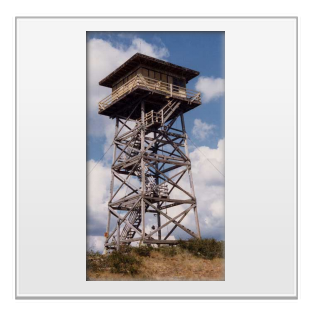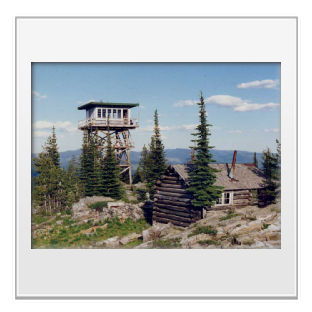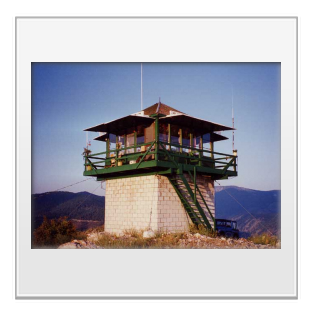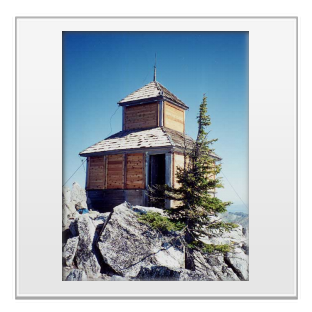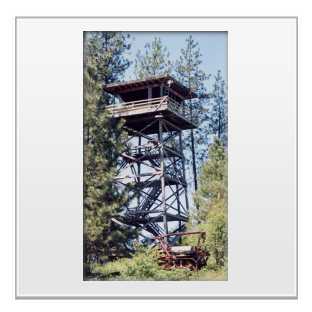Forest Fire Lookouts - Passport in Time
Main menu:
PIT Highlights > PITsters' Corner
Forest Fire Lookouts: A Century of Service
by Jill A. Osborn
Fire lookouts—in a blaze of summer heat or covered with snow, what more romantic image of solitude is there? Second only to Smokey Bear, fire lookouts have become one of the FS’s most widely recognized icons. At one time in the 1940s, there were close to 4,000 fire towers in NFs across the United States. Now there are fewer than 900. Computerized lightning detection systems and air patrols have taken over much of the role of lookouts in detecting and locating wildfires. In severe fire seasons, some fire lookouts are still staffed, because they offer views not covered by other systems. But for the most part, they are a dying breed. Many were removed from their mountaintop locations during the 1970s and ’80s. Some were dismantled and reconstructed in historical parks as romantic reminders of the past. Others were simply dismantled and discarded. I see this as a great loss.
It is a loss I suffered personally my first year with the FS, more than 20 years ago. Unlike many others in the FS, I do not come from a FS family. I had no experience with fire or fire lookouts. I didn’t have the romantic attachment that those who actually served as lookouts have. But I was a skier. During my first winter as a FS employee, I took the ski lift up Chewelah Peak on the Colville NF in Washington for my first run of the season and fell in love at the top. There stood an amazing tower, completely snow encrusted and silhouetted against a bright blue winter sky: Chewelah Peak Fire Lookout. I was hooked. I could hardly wait to get back to the office on Monday to find out how many fire lookouts there were, how old they were, and how we could protect them.
I learned that most of the lookouts were built in the 1930s and ’40s, many by the CCC; there weren’t many left; and many were slated to be removed, as they were no longer in use and were a safety concern. As an archaeologist, of course, I saw only the opportunity to manage this amazing resource with foresight instead of hindsight after we’d lost all but one.
I set to work on Chewelah Peak, because it seemed an obvious one to save. The community of Chewelah referred to it as “their” lookout, residents regularly hiked up the ski slopes in the spring and summer to picnic in its shadow, it was a much-loved view from the town in all seasons, and unlike most lookouts, it had visitors even in the winter. Thousands of skiers saw Chewelah Peak Fire Lookout every time they took the lift for another run, and on sunny winter days, they sat around its base to eat their lunch. But I lost the battle. Chewelah Peak Fire Lookout was removed from its mountaintop in 1985.
Years later, my niece was a ski instructor at that ski area. She saw a picture in my photo album of my skiing buddies posed in front of the lookout. She was astounded and wanted to know what it was and why it was gone. That was 20 years later. That’s how soon things are forgotten if we don’t preserve a few for the younger generation to enjoy.
I went on to other things in my FS career, but I never forgot Chewelah Peak. Every time I heard about another lookout in danger of demolition or removal, my heart sank. I mourned the loss of Chewelah Peak Lookout each time. There were moments of victory, especially after we started PIT and began restoring fire lookouts for the recreation cabin rental program, but it was not enough. However, I would not tell this story if it didn’t have a happy ending.
“Fire lookouts and the people who served in them are at the core of the agency’s mission of ‘caring for the land and serving people.’ A celebration of our past would not be complete without a celebration of fire lookouts, past, present, and future, and I am thrilled to be a part of the Forest Service’s New Century of Service. Since I was a young child, I’ve been hiking with my family to lookouts and meeting with the ‘rangers’ at the top (my dad loved to talk to them), and I truly believe the romance of their work helped lead me and many others to this profession.”
—Sally Collins, Associate Chief, USDA Forest Service
The Forest Fire Lookout Association (FFLA) has been diligently tracking, documenting, saving, and restoring fire lookouts and preserving the stories of the people who staffed them for over 12 years. They have done this despite sometimes overwhelming challenges—continued degradation of lookout towers because of weather and disuse, and federal policies that encouraged the removal of lookouts out of concern for public safety. In three years, in 2005, the FS will celebrate its first century of service—that century when lookouts were essential to our job. To prepare for our “New Century of Service,” many of the planners of this celebration looked backward to our legacy for inspiration and guess what they saw—forest fire lookouts! It should come as no surprise that the motto of the FS Heritage Program is “Heritage: It’s about Time!”
The FS and all the communities it serves understand that lookouts are an enduring symbol of the work the agency does. As a part of the New Century of Service celebration, the FS has formed a partnership with the FFLA. One of the main goals is to save the lookouts that are left, if not in structure, at least through the stories of the people who served in them (read one woman’s story of what it means to be a lookout).
“In 2005, the Forest Service will celebrate its New Century of Service by looking back and honoring one of our most enduring symbols—fire lookouts. As PIT volunteers, you have helped us save so many of these amazing structures, I would like to personally thank you. It is because of you, we have so many fire lookouts left and can now give them all their due recognition! Thank you!”
—Joel Holtrop, Deputy Chief, State and Private Forestry, USDA Forest Service
PIT is a big player in this endeavor. PIT volunteers have already restored many towers and ground cabins, most of which are now recreation cabin rentals (look for the symbol in the project listings). Many lookouts also are still used part-time for fire detection. They are not yet dinosaurs, and with the current recognition of their importance as symbols of the FS and its land stewardship ethic, they are likely to be recognized for years to come as an important and permanent contribution to “caring for the land and serving people.”
